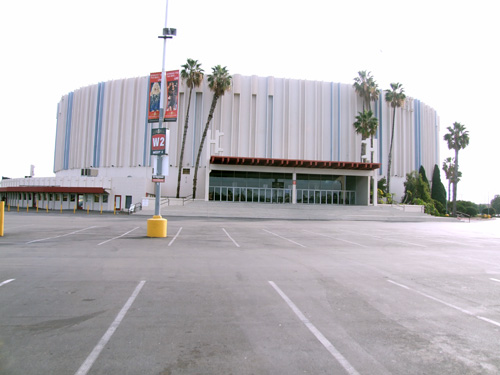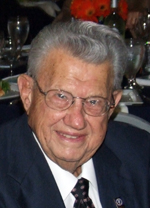Editor’s Note: In my quest to find Jewish stories wherever I go, I decided there is no place like home to illustrate the concept that “there is a Jewish story everywhere.” Interstate 8 roughly follows the traditional route that settlers took in their covered wagons in the mid-19th century to get to San Diego from the American Southeast. In this I-8 travel series, I plan to reverse their route, and to travel inland from the coast of California, heading east on the I-8 until I reach that freeway’s terminus in Arizona. Along the way, I will take readers to venues within a few miles of the freeway’s exits. Please note that over I-8’s California segment, the number designation of a freeway exit corresponds with that exit’s distance from the western terminus of I-8. Throughout this series, which we plan to run on Thursdays, we will use those numbers as aids to help our readers find the places we visit.

Interstate 8, Mile 1: Sports Arena Boulevard ~ Valley View Casino Center
By Donald H. Harrison


(Photo: Donald H. Harrison)
SAN DIEGO –The International Sports Arena, today known as the Valley View Casino Center, was largely the dream of one Jewish San Diegan: Robert Breitbard.
Breitbard loved football, he loved playing it, and he loved coaching it, both at San Diego State College (now University) and at Hoover High School. In truth, he loved all sports and his collection of their memorabilia became the nucleus of San Diego’s Hall of Champions. The collection was enhanced with replicas of the awards bestowed by the Breitbard Athletic Foundation upon star athletes who either resided in San Diego, or played outstandingly for its sports teams. The Hall of Champions has been a feature of Balboa Park since 1961.
Breitbard’s incredible enthusiasm for sports prompted him in 1963 to propose to the Western Hockey League (WHL) that San Diego be granted a franchise. Fine, the WJL owners told Breitbard, you can have one so long as you pay $75,000 to the league and provide your team an arena capable of seating 11,000 people at hockey games. The terms were steep, but Breitbard accepted.
Next he persuaded the City of San Diego to provide a 50-year master lease on an 80-acre site in what was then known as the Midway-Frontier area of the city. In return, he promised to build with private capital the International Sports Arena on 38 of those acres. The other 42 acres he proposed for commercial development. Breitbard then formed the San Diego Arena Lease Co., which, as a non-profit organization with the City of San Diego’s blessing could issue tax-exempt bonds to finance the constrution of the arena. Additionally, he created Sports Enterprises, a for-profit company which became the lessee.
Ground was broken on November 18, 1965 by crews working for San Diego general contractor Gene Trepte, who had to import 40,000 cubic yards of dirt to firm up a base near an old river bed for the 121-million pound sports arena, according to biographer Dan Fulop, who wote Bob Breitbard: San Diego’s Sports Keeper. (That biography was published in 2012, two years after Breitbard died at the age of 91.)
Breitbard hired Mike McNab, who had been general manager of the Vancouver Canucks, to be the first head coach and general manager of San Diego’s new hockey team, which, as the result of a name-the-team contest, was called the San Diego Gulls.
The $6.4 million stadium was finished in time for the Gulls inaugural game against the Seattle Totems which, surprisingly, the Gulls won– surprisingly, because over the rest of the season, the team’s record was 22 wins, 47 losses and 3 ties. Notwithstanding this last-place finish, the Gulls created hockey-mania in San Diego, averaging in their first season 8,751 paid spectators per game. The season total of 315,201 paid admissions set a WHL record, acording to biographer Fulop.
The success of the Gulls made owners in the National Basketball Association (NBA) wonder whether San Diego fans might be just as excited and loyal to a professional basketball team. Breitbard thought they would, and this led to an announcement in January 1967 that the following season San Diego would have its own NBA team. Fulop reported that with San Diego’s motto then being “A City in Motion” and Convair building Atlas rockets for the National Aeronautics and Space Administration, the name San Diego Rockets was chosen from among numerous entries in another name-the-team contest. Jack McMahon was named the first head coach.
Like the Gulls, the Rockets had a dismal first season, winning only 15 of their 82 games in 1967-68–the most losses any NBA team had suffered in a single season. But unlike the Gulls, the Rockets did not excite the imagination of the fans. Average attendance was only 4,606 per game, far less than that of the Gulls. But Breitbard thought he had a way to fix that. For the next season, he was able to obtain as a draft pick a star player from the University of Houston, Elvin Hayes, nicknamed the “Big E.” What a difference Hayes made! He helped the Rockets in their second season to compile a 37-45 record and win a playoff berth. At the same time, average attendance climbed to 6,054.
With Hayes starring for the Rockets, and Willie O’Ree playing for the Gulls, Breitbard’s could count on the celebrity of these players to stoke the fans’ enthusiasm. O’Ree previously had played for the Boston Bruins of the National Hockey League, and because he was the first African-American to play in that league, he was sometimes honored as “The Jackie Robinson of the NHL.”
Despite the presence of these celebrities on his teams, Breitbard’s sports empire was headed for trouble. While Hayes boosted attendance for the Rockets, paid admissions still did not climb to the level of attendance enjoyed by the Gulls. The 42 acres of land surrounding the Sports Arena never attracted a sustainable commercial development, and overdue payments mounted up to the NBA for its franchise, as well as to the City of San Diego for bond payments and interest.
Momentary diversion from Breitbard’s financial troubles came in 1971 when his International Sports Arena hosted the NBA’s 21st Annual All Start Game, at which 14,378 people enjoyed the playing of Kareem Abdul Jabbar (then still named Lew Alcindor), Wilt Chamberlain, Willis Reed, Oscar Robinson, and Jerry West, among others.
Unable to pay his mounting debts, Breitbard sold the Rockets in June 1971 to a partnership in Houston, Texas, where the team still plays today. A month later he forfeited ownership of the International Sports Arena through sale of its lease to Canadian entrepreneur Peter Graham.
For a while at least, Breitbard still had the popular Gulls. He hoped that the team could be elevated into an NHL franchise, but he didn’t reckon on the fact that Graham wanted his own hockey team in the arena. And Graham was known as a tough businessman. When the national Republican party failed to agree to his terms for leasing the International Sports Arena in 1972, he told the GOP to take its national convention elsewhere.
Prompted also by the controversy engendered by the ITT affair, in which the Nixon administration was accused of favoring ITT in an anti-trust investigation in return for financial backing for the GOP convention, the Republicans relocated their convention to Miami, much to the City of San Diego’s great consternation.
Graham was just as tough on Breitbard, reportedly requiring the highest rent in the Western Hockey League, and this, along with higher player salaries, resulted in Breitbard losing money on what previously had been a successful franchise, according to biographer Fulop.
Eventually Graham decided to grant a World Hockey Association team — the New Jersey Knights–an exclusive five-year lease at the International Sports Arena, leaving the Gulls with no where to play. Breitbard and the Gulls formally were evicted on June 2, 1974, leading the Gulls to fold and the Western Hockey League to disband. Renamed as the San Diego Mariners, the Jersey Knights never caught on as the Gulls before them had. They played only three years before they too were folded.
In May 1985, Graham was replaced by Vincent Ciruzzi as operator of the International Sports Arena, marking the end of a stormy 14-year tenure. After Ciruzzi came Ernest Hahn, the current operator.
Breitbart spent much of the remainder of his life in his office at the Hall of Champions in Balboa Park, greeting visitors and reminiscing with sports celebrities about his one-time Hoover High School classmate Ted Williams of Boston Red Sox fame and other star athletes who had made San Diegans very proud.
Near the end of his life, Breitbard moved to Seacrest Village Retirement Home in Encinitas, California, which is operated by a non profit arm of the local Jewish community. He died there in his sleep in May of 2010 at the age of 91.
At the funeral service at Tifereth Israel Synagogue in San Diego, Rabbi Leonard Rosenthal said: “Bob Breitbard never cared about a person’s station in life, or their background, or religion, or ethnicity, or the color of their skin, or what they could do for him. He had a gift for making anyone he met and spoke with feel they were the center of his universe and that no matter who they were or their station in life, they were a unique and valuable human being. He would just as warmly embrace the woman who cleaned his house as he would a captain of industry.”
{Road information: Sports Arena Boulevard is a westbound exit and eastbound entrance to the Interstate 8 located about 1/2 mile east of its terminus. To reach the Valley View Casino Center, known formerly as the San Diego Sports Arena, rollow signs through the interchange to Sports Arena Boulevard and then turn left into Valley View Casino Center parking lot. Sponsored by the Valley View Casino located in northern San Diego County for advertising purposes, the Arena does not offer on-site gambling.}
Next in the I-8 series: Mile 2, Rosecrans exit to Louis Rose Point
Harrison is editor of San Diego Jewish World. You may comment to him at donald.harrison@sdjewishworld.com, or post your comment on this website provided that the rules below are observed.
*
__________________________________________________________________
Care to comment? We require the following information on any letter for publication: 1) Your full name 2) Your city and state (or country) of residence. Letters lacking such information will be automatically deleted. San Diego Jewish World is intended as a forum for the entire Jewish community, whatever your political leanings. Letters may be posted below provided they are responsive to the article that prompted them, and civil in their tone. Ad hominem attacks against any religion, country, gender, race, sexual orientation, or physical disability will not be considered for publication. There is a limit of one letter per writer on any given day.
__________________________________________________________________
Pingback: I-8 Jewish Travel: San Diego State University - San Diego Jewish World